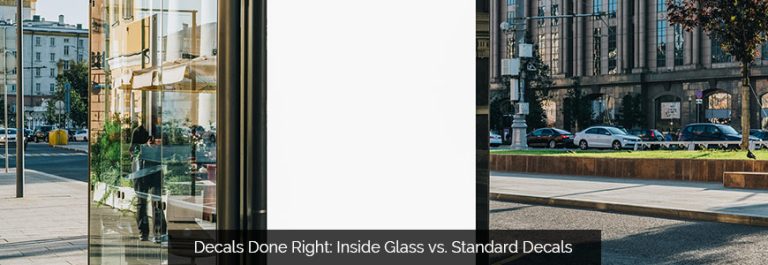Installing a window decal is as simple as peel-and-stick, but choosing between inside glass and standard printing can be a little tricky for first-timers.
With that in mind, today’s post breaks down the pros and cons of standard and inside glass decals. Read on to learn the major differences between these two decal options, and find out which is right for you.
What are inside glass decals and how do they differ from standard decals?
Inside glass decals are meant to be viewed from the outside, but, as the name suggests, are placed on the inside face of the glass. Accordingly, the adhesive will be on the front of the decal, and the design will be printed on the back, where it is visible through the clear vinyl material that separates it from the adhesive.
In contrast, standard decals are applied directly to the exterior surface of the glass. They could be called “outside glass” decals.
Which decal is best for me?
There are pros and cons to choosing inside glass over standard decals.
On the plus side, inside glass decals tend to last longer than their standard counterparts since they’re protected from exposure to elements and any potential vandalism from mischievous passersby. Thus, if you’re living somewhere with hostile weather conditions, or you’re fortunate enough to have a storefront in an area with high-volume foot traffic, inside glass options are recommended.
On the other hand, inside glass windows do not perform well on reflective surfaces in areas that get a lot of sunlight. That’s because the reflection obscures the graphic behind that surface, unlike with standard decals, which are placed directly onto the surface.
Inside glass decals also don’t work particularly well on tinted or frosted windows for obvious reasons. If you’re using either, opt for a standard decal.
Best practices for inside glass and standard decals
Though there are some disadvantages to inside glass, they can mostly be offset by following these best practices (many of which also apply to standard decal design and installation):
- Increase visibility through proper use of color and contrast. Decals with poor color and contrast will not be visible to your audience. This is especially true of inside glass decals, which are already at a disadvantage because of the way they can reflect light over the interior graphic.As a general rule of thumb, you want a light colored background paired with dark lettering, or vice versa. Adding opaque backgrounds to your design is another simple way to ramp up the contrast and thereby increase visibility.
And don’t assume you’re off the hook with clear decals, either! Complementary color and contrast can still be achieved by factoring in how the design works with the inside space of the building, as well as any furniture.
- Avoid placing decals in high-glare locations. Though standard decals aren’t affected quite as badly as inside glass, neither should be intentionally placed in areas that get a lot of glare from the sun. After you’ve picked the perfect spot, check back on it multiple times throughout the day to see how the sun’s movement changes things. The last thing you want is a dazzling spot of sunlight obstructing your decal at peak business hours!
- Keep your windows clean. Dirty windows make decals harder to see. In the case of standard decals, dirty windows can also damage the decal design and adhesive.
- Consider the alternatives. Vinyl lettering can also be used in place of standard and inside glass decals. Speak to a member of the Signworld business alliance to learn more about this option.
Learn more about decals or custom-orders yours – get in touch with a member of the Signworld alliance at https://www.signworld.org




